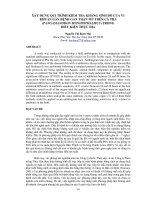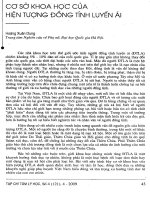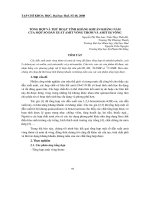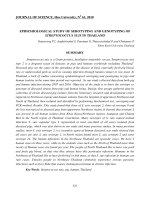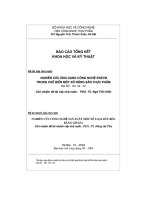Báo cáo nghiên cứu khoa học: "nghiên cứu dịch tễ học của serotyping và kiểu gen của vi khuẩn Streptococcus suis ở Thái Lan" pps
Bạn đang xem bản rút gọn của tài liệu. Xem và tải ngay bản đầy đủ của tài liệu tại đây (26.57 KB, 4 trang )
321
JOURNAL OF SCIENCE, Hue University, N
0
61, 2010
EPIDEMIOLOGICAL STUDY OF SEROTYPING AND GENOTYPING OF
STREPTOCOCCUS SUIS IN THAILAND
Nutravong TC, Angkititrakul S, Panomai N, Tharavichitkul P and Chimanee P
Khon Kaen University, Thailand
SUMMARY
Streptococcus suis is a Gram positive, facultative anaerobic coccus. Streptococcus suis
type 2 is a frequent cause of diseases in pigs and humans worldwide including Thailand.
1
Diseased pigs are the cause of the spreading of the disease in food, especially fresh pig blood,
raw or undercooked pork as well as causing infection through human contact to raw meat. In
Thailand, a lack of studies concerning epidemiological serotyping and genotyping in pigs and
human isolates in the same time period was reported. So our study collected data from both pig
and human infection during 2007 and 2010. Objective of the study is to know the serotype or
genotype of diseased strains from pigs and human being. Design. Our groups gathered data by
collecting of eleven diseased pig isolates from the Veterinary research and development center
(uppermost Northeast region) and human isolates from the hospital of uppermost Northeast and
North of Thailand, then isolated and identified by performing biochemical test, serotyping and
PCR method. Results. This study found that three of S. suis serotype 2, three of serotype 9 and
the less non-typical in diseased pigs from uppermost Northeast region. It showed that serotype 2
was present in all human isolates from Khon Kaen,(Northeast region), Lumpoon and Chiang
Mai in the North region of Thailand. Conclusion. Many serotypes of S. suis caused animal
infection. S. suis capsular type 2 represented at least one-third of all cases isolated from
diseased pigs, which was also shown in our study and many previous studies. In many previous
studies, most S. suis serotype 2 is a causative agent of human diseased, our study showed that
all cases are also S. suis serotype 2, in North region found most S. suis serotype 2 and some
serotype 14. The human infections in the Northeast Thailand are sporadic cases. We have 2
human cases in three years, while in the endemic area such as the North of Thailand more than
twenty of Human cases are found per year. The people of North Thailand like to have raw pork
and fresh pig blood, so that why they always have this particular infection. Humans in the
Northeast of Thailand like to have fresh beef or fish meat, so that S. suis infection in humans are
rare cases. Unlucky people in Northeast Thailand commonly experience serious parasitic
infections such as liver fluke that causes cholangiocarcinoma in chronic infection.
Key Words: Streptococcus suis, pig, human, Thailand
322
1. Introduction
Streptococcus suis is positive Gram, facultative anaerobic cocci. It is an
important pathogen in pigs. These organisms have been found in the nasal tract and
tonsils of healthy pigs and causes severe diseases such as pneumonia, septicemia,
meningitis, endocarditis, arthritis, abortion in pigs and sudden death in piglets. It is a
serious zoonosis in human, with most case occuring in workers that have frequent
exposure to sick or carrier pigs including raw pork contaminated with S. suis.
Many serotypes of S. suis cause clinical infection in pigs or piglets, one-third to
nearly half of the isolates are capsular serotype 2. The other types 3, 4, 8, 5, 7 and ½
have been reported in China between 2003 and 2007. A spanish group survey of
palatine tonsils from healthy pigs suspected the origin of transmission to humans is
carried out. They reported half of these isolated are serotype 2, the less 15, 9, ½, 6, 4, 24,
1, 3, 21, 22, 23, respectively.
Human infection caused by S. suis is first reported in 1968 and becomes serious
zoonosis in many countries with intensive swine production in Europe as Netherlands,
United Kingdom, Denmark, France, Germany, Sweden and Italy, in Asia as Hong Kong,
Thailand, Singapore Taiwan and Viet Nam.
Thailand has cases reported in central, north and northeast Thailand. Most
reports from humans in Thailand are not classified as these organisms by any typing
method. Genetic analysis (PFGE) of S. suis isolated from six healthy pigs and sixty-
three human cases in northern Thailand has been reported since 2006. However, the
serological or molecular epidemiological study in diseased pigs has not been
investigated. This study carried out serological or molecular epidemiological
relationships in diseased pigs in some parts of northern including northeastern of
Thailand and compared them to human isolates in North and Northeast Thailand.
2. Methodology
Our groups gathered data by collecting of eleven diseased pig isolated from
Veterinary research and development center (North and uppermost Northeast region)
and Seventy four humans isolated from the hospitals of uppermost Northeast and
Northerrn Thailand. Humans were those already diagnosed by a clinician and confirmed
the infection was caused by this agent, by the microbiogical laboratory in each hospital.
S. suis is identified and classified by morphological, biochemical, serological
characteristics and performed genotyping by PCR assay for detection of Streptococcus
suis and S. suis serotype 2. In this study confirmatory biochemical tests are performed
to identify Streptococcus suis by Gottschalk, M et al. (1991), then further identifies to
serotype 2 capsule by coagglutination test from SSI Copenhagen, Denmark and
confirmed to serotype 1, 2, 7, 9 or 14 by PCR method.
323
3. Results
Seventy-four of S. suis human isolates have confirmative tests using the
Gottashalk method (show negative growth in 6.5% NaCl, VP negative, hydrolysis of
esculin positive; trehalose, Lactose, salicin and sucrose positive, amylase production
positive, glycerol negative and give alpha hemolysis on sheep blood agar). The capsular
type 2 identification is performed by coagglutination tests.(SSI, Copenhagen, Denmark)
The PCR method is using 16s and CPS 1,2,7,9 and 14 gene amplification for alternated
confirmatory tests
This study finds that three of S. suis were serotype 2, three were serotype 9 and
the other nontypical in diseased pigs from the uppermost Northeast region.
It shows that serotype 2 was present in two humans isolated from Khon
Kaen,(Northeast Thailand), fifty-three isolated from Lumpoon and twenty isolated
Chiang Mai in the Northern of Thailand.
Table 1. Clinical and Laboratory diagnosis of Streptococcus suis from Pig and Human infection
Samples No of Streptococcus suis* No of S. suis serotype 2
Disease Pigs
Humans
11
74
3
73
Three isolates are serotype 9
4. Discussion
Many serotypes of S. suis are caused by animal infection. S. suis capsular type 2
represents at least one-third of all isolated diseased pigs, which was also found in our
study, and many previous studies. Many previous studies show that most S. suis
serotype 2 is a causative agent of human disease. Our study also shows that almost all
cases are also S. suis serotype 2, in North Thailand find most S. suis is serotype 2 and
some serotype 14. The human infections in the Northeast Thailand are sporadic cases.
We collected 2 human cases in three year, while in the endemic area such as Northern
Thailand found more than twenty human cases per year.
5. Conclusion
The people in the North of Thailand liked to have raw pork and fresh pig blood,
which is that why they always have that infection. Humans in the Northeast of Thailand
like to have fresh beef or fish, so that S. suis infection in humans are rare cases. One
human case had only contact with pigs without a history of having raw pig meat. This
finding indicates that small skin abrasions can be the source of infection. Unlucky
people in the Northeast region commonly experience serious parasitic infections such as
liver fluke, which caused cholangiocarcinoma in chronic infection.
324
Acknowledgements
We would like to thank the Research & Diagnostic Center for Emerging
Infectious Diseases, Khon Kaen University, and Faculty of Medicine, Khon Kaen
University for kindly giving financial support for this study.
REFERENCES
1. Arends JP, Hartwig N, Rudolphy M and Zanen HC. Carrier rate of Streptococcus suis
capsular type 2 in palatine tonsils of slaughtered pigs. Journal of Clinical
Microbiology.1984; 20: 945-947.
2. Arends JP and Zanen HC. Meningitis caused by Streptococcus suis in Humans. Review.
Infectious Disease.1988;10: 131-137.
3. Chotmonkol V, Janma J and Kawamatawong T. . Streptococcus suis meningitis: Report
of a case. Journal Medical Association Thailand.1999; 82: 922-924.
4. Gottschalk, M Higgins, R Jacques, M Beaudoin, M and Henrichsen, J. . Isolation and
characterization of Streptococcus suis capsular types 9–22. Journal Veterinary
Diagnostic Investigation.1991; 3: 60–65.
5. Lun,,ZRWang, QP Chen, Z-G Li, A-X Zhu, Z-Q. .Streptococcus suis: an emerging
zoonotic pathogen Lancet Infectious. Disease. 1991; 7: 201-209.
6. Marios, C Bougeard.D Gottschalk, M and Kobisch, M. Multiplex PCR assay for
detection of Streptococcus suis species and serotype 2 and ½ in tonsils of live and dead
pigs. Journal of Clinical Microbiology. 2004; 42: 3169-3175.
7. Normile. Infectious disease:WHO probes deadliness of China’s pig-borne disease.
Science. 2005; 309: 1308-1309.
8. Pootong P, Boongrid P and Phuapradit P. Streptococcus suis meningitis at Ramathibodi
hospital. Ramathibodi Medical Journal. 1993; 16: 203-207.
9. Suankratay, C, Intalapaporn, P, Nunthapisud, P Arunyingmonkol ,K and Wilde, H. .
Streptococcus suis meningitis in Thailand. Southeast Asian Journal Tropical Medicine
Public Health. 2004; 35: 868-876.
10. Tarradas C, Luque I, Andres DD, Abdel-Aziz Shahein YE, Pons P, Gonzalez F, Borge C
and Perea A. Epidemiological relationship of human and swine Streptococcus suis
isolates. Journal of Veterinary Medicine Series B. 2001; 48: 347-355.


